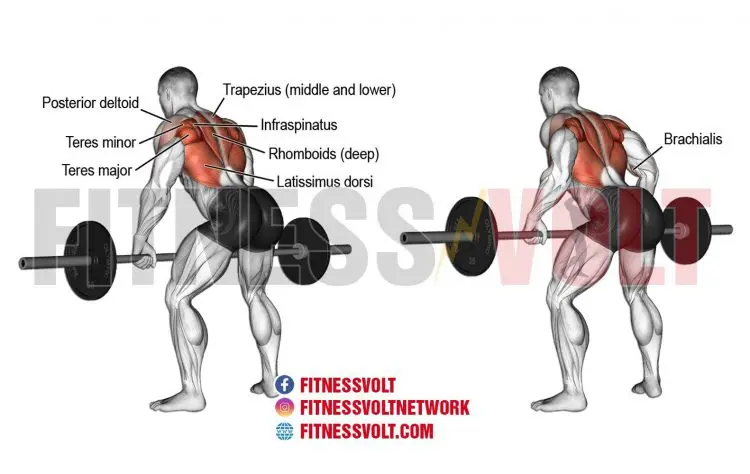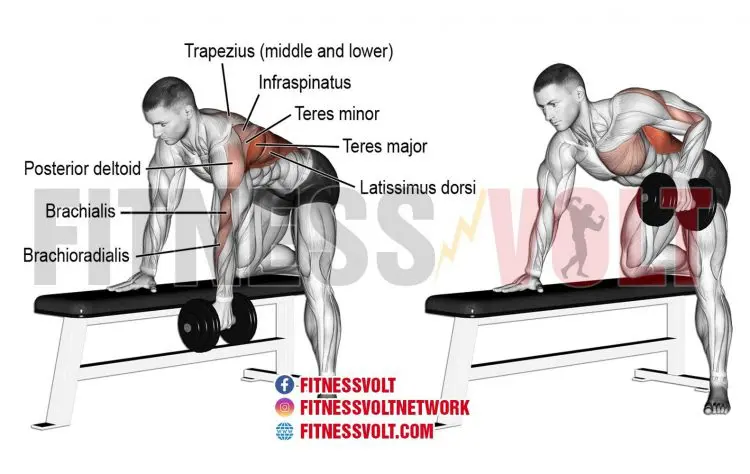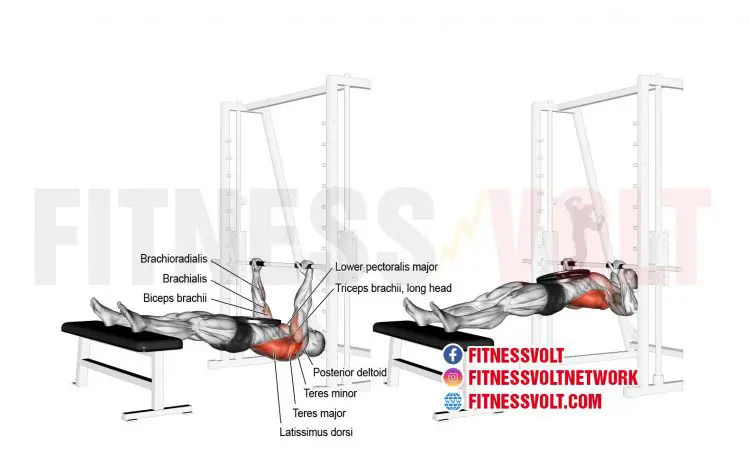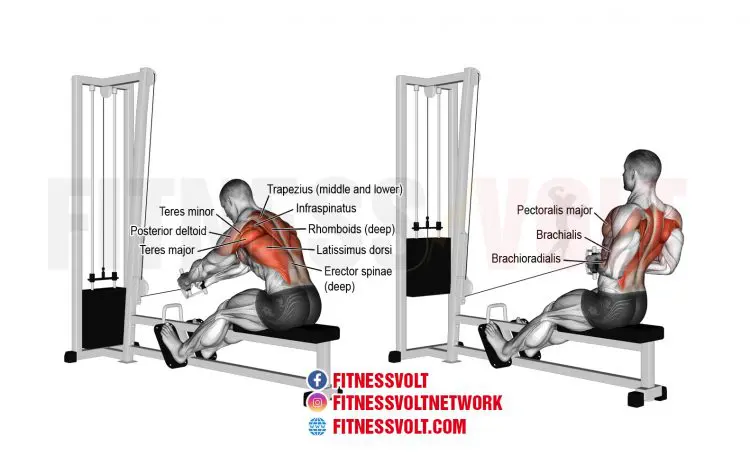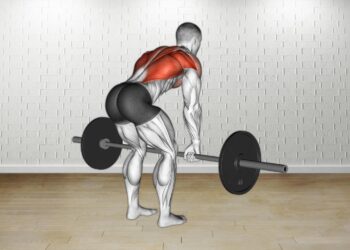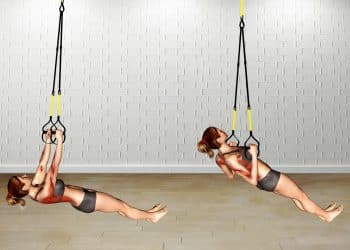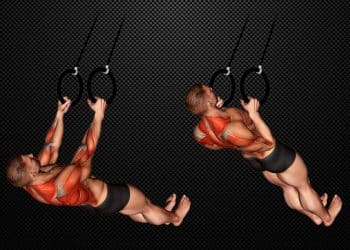The best rowing exercises are simple movements. Anyone can do them and experience the benefits.
Rowing exercises or variations of rows are key components of building a very muscular, strong, and functional back. The name comes from the motion of rowing, like how someone would row a boat. This requires the muscles that make up the upper posterior chain (backside of the body).
But what most people don’t realize is that rowing exercises work the biceps and forearm muscles, too. The advantage of using maximal weights with rows elicits this growth response.
As a personal trainer with over five years of experience, I’ve helped numerous clients transform their backs with rowing exercises. In this article, I reveal the 12 best rowing exercises to add mass to your posterior chain.
Recent Updates: On July 20, 2024, Fitness Volt’s Senior Editor Vidur Saini (American Council on Exercise-CPT) updated the article and added actionable expert tips throughout the piece to improve the reader experience. Level Up Your Fitness: Join our 💪 strong community in Fitness Volt Newsletter. Get daily inspiration, expert-backed workouts, nutrition tips, the latest in strength sports, and the support you need to reach your goals. Subscribe for free!
12 Best Rowing Exercises
Add the following exercises to your arsenal:
- TRX Row
- Resistance Band Row
- Barbell Bent-Over Row
- Single-Arm Dumbbell Bent-Over Row
- Inverted Row (Feet Elevated)
- Smith Machine Row
- Machine Row
- Landmine Row
- Standing Single-Arm Cable Row
- Seated Cable Row
- Kettlebell Row
- Pendlay Row
Each exercise works the same muscles, although some variations may emphasize certain muscles of the back more than others.
For each exercise, I’ll provide exercise instructions, tips, and ways to increase the difficulty.
1. TRX Row
| Sets & Reps | 3 x 10-15 |
| Equipment Needed | TRX Suspension Trainer |
| Target Muscles | Lats, rhomboids, rear deltoids, biceps |
Not everyone has access to a fitness center. That’s totally fine and you don’t need to in order to build your back muscles. The TRX suspension trainer utilizes your bodyweight as resistance. It’s an extremely beneficial, convenient, and versatile training tool that is widely used by many.
The instability of the TRX forces core engagement, making it an excellent option for both back development and functional strength,” says Saini.
To do it:
- Attach the TRX to a high point (e.g. door anchor, tree, rafters, etc) with the straps fully shortened
- Grip the handles and lean back so that you have to hold yourself up.
- Keep your chest up, core tight, and shoulders back.
- Pull yourself toward the handles by driving your elbows back behind your body. Use your hands only to grip the handles. Your back muscles should engage to execute the movement properly.
- Slowly let your body lean back to where it was at the start and repeat.
Coach Tips:
- The closer your feet are to the object that the TRX is attached to, the more challenging the exercise will be. This creates more resistance from your body weight. Although, if you place your feet too close, you’ll end up doing an inverted row.
- Make sure your feet remain planted and are not able to slide or move during the exercise.
- Keep your arms neutral. Don’t tuck them into your sides and don’t flare your elbows out wide.
How to increase exercise difficulty
Try these different variations — single-arm TRX row, rotating single-arm row, inverted TRX row, weighted TRX row (wear a weighted backpack or something similar)
| Difficulty | Progression | Regression |
| Beginner | Increase angle, add volume | Seated cable row |
2. Resistance Band Row
| Sets & Reps | 3 x 15-20 |
| Equipment Needed | Resistance Band |
| Target Muscles | Lats, rhomboids, rear deltoids, biceps |
Saini explains that this exercise is perfect for beginners or as a warm-up; the resistance band row allows for a controlled movement and focuses on proper form.
Resistance bands are the perfect at-home exercise tool, however, you can still use them at the gym. Now, there are a few different levels of resistance bands and you can combine them for even more resistance. Consequently, performing rows with bands can be just as challenging as using weights or anything else.
You can step on the bands to create the resistance or you can anchor them to something low near the ground like a machine, bench, under a table, etc.
To do it:
- After finding your ideal level of resistance by securing the bands, bend forward at the hips while keeping your back straight.
- Bend your knees slightly and keep your arms close to your sides.
- Pull the bands back as far as you can by driving your elbows behind you and squeezing your back muscles.
- Slowly return your arms to an extended position until you feel a stretch in your lats and then repeat.
Coach Tips:
- Make sure to adjust the length of the band/s that it provides resistance throughout the entire range of exercise movement. You may have to make them shorter by using a wider stance or by standing a little more upright. This will avoid losing tension during the row.
- Control the negative part of each repetition. It’s tempting to want to let the bands pull you back, but you want to keep your muscles engaged.
How to increase exercise difficulty
If you’re training with bands, there are a few methods for making the exercise more difficult. For example, you can spread your feet wider on the bands to create more resistance.
Also, you can hold the top part of each rep for 2-3 seconds, or you combine bands together for more resistance.
| Difficulty | Progression | Regression |
| Beginner | TRX row | Use lighter band |
3. Barbell Bent-Over Row
| Sets & Reps | 3 x 8-12 |
| Equipment Needed | Barbell, Weights |
| Target Muscles | Lats, rhomboids, traps, rear deltoids, erector spinae |
“A classic compound lift, the barbell row is a cornerstone for building a thick and powerful back,” says Saini.
Few back exercises even come close to the barbell bent-over row as far as the versatility that this staple movement provides. Not entirely convinced? An ACE (American Council On Exercise) sponsored study actually proved that it elicits the most overall activation of the back muscles symmetrically from top to bottom when compared to other common back exercises. (1)
But we don’t need a study to convince us that it’s a must-have back exercise.
To do it:
- Ideally, start with the barbell racked below your knee to place less stress on your lower back.
- Grip the barbell so that your hands are just outside of shoulder-width.
- Tighten your core and keep your back straight then lift the barbell up by driving through your heels and take a few small steps back.
- Bend your knees a little and then bend forward at the hips until your torso is slightly above parallel to the floor.
- Keep the barbell close to your body and your arms slightly tucked but not touching your sides.
- Use your back muscles to pull the weight up and drive your elbows behind you. The bar should reach about mid-stomach.
- Slowly lower the weight back down and repeat.
Coach Tips:
- If you’re straining, lower the weight and focus on having good form. You don’t want to place too much stress on your lower back.
- If you do have a weak lower back, the bent-over row is a good way to correct this issue.
- Using cheat reps is acceptable sometimes, but only after you can do the exercise with the correct form.
How to increase exercise difficulty
Use a reverse grip that’ll engage more of the biceps.
Another option is to perform dead-stop reps where you place the barbell on the floor during each rep and then row it.
Utilize the high row to emphasize the upper back muscles.
If you’re really advanced, use a mixed grip where one hand is pronated (overhand) and the other is supinated (underhand). This may allow you to use heavier loads and avoid grip slipping but focus on your form first and foremost.
| Difficulty | Progression | Regression |
| Intermediate | Pendlay row | Dumbbell bent-over row, inverted row |
4. Single-Arm Dumbbell Bent-Over Row
| Sets & Reps | 3 x 8-12 (per arm) |
| Equipment Needed | Dumbbell, Bench (optional) |
| Target Muscles | Lats, rhomboids, traps, rear deltoids, erector spinae |
The single-arm dumbbell bent-over row is similar to the barbell row except you have more freedom of movement. For example, you can use a neutral grip, and because the bar doesn’t stop at your torso as the barbell does, you can pull even higher to get a more pronounced contraction in the muscle of your back.
Saini highlights that unilateral work helps correct imbalances and encourages greater activation of stabilizer muscles. So, if you’re weaker on one side, then you can perform a few additional reps on either side to fix this.
Use a bench or something to lean onto with your non-working hand.
To do it:
- Place the dumbbell on the floor, on a bench, or leave it on the rack so that you can take it off from there and jump right into the exercise.
- Use a neutral grip and either place the opposite knee of the working arm on a bench or lean onto the rack with the non-working arm. Just make sure you don’t block the rack if there are other people at the gym.
- Bend forward at the hips and bend your knees too.
- Keep your chest up and maintain a straight back.
- Pull the dumbbell up by driving your elbow back behind you as high as you can and then slowly extend your arm back toward the floor.
- Make sure to alternate arms to work both sides.
Coach Tip:
- Make sure to keep your torso neutral and don’t go too heavy to where you’re leaning excessively toward the same side as the working arm.
How to increase exercise difficulty
You can perform dead-stop reps to improve concentric power and explosiveness. To do this, allow the dumbbell to sit on the floor for a second before performing the positive portion of the rep.
Perform the high row to emphasize the upper back muscle more.
| Difficulty | Progression | Regression |
| Intermediate | Increase weight, single-arm landmine row | Resistance band row, inverted row |
5. Inverted Row (Feet Elevated)
| Sets & Reps | 3 x to failure |
| Equipment Needed | Smith Machine, Barbell (or sturdy horizontal bar) |
| Target Muscles | Lats, rhomboids, biceps, rear deltoids |
Still a very underrated movement, the inverted row is one of the most underrated, yet best rowing exercises that you can do. The reason being is that you’re able to utilize a large percentage of your body weight to execute this movement. More weight equals more potential for muscle growth and strength.
Well, doing it with your feet elevated increases the difficulty even more than keeping your feet on the ground. Now, you may have to start with your feet on the ground, and that’s OK. Just do it until you think you can progress.
Level Up Your Fitness: Join our 💪 strong community in Fitness Volt Newsletter. Get daily inspiration, expert-backed workouts, nutrition tips, the latest in strength sports, and the support you need to reach your goals. Subscribe for free!
Saini says this is a fantastic bodyweight exercise that is easily adaptable to all fitness levels and a great way to progress towards pull-ups.
This is a unique rowing variation in that it’s a great exercise for working the upper back and traps due to the fact that the bar is roughly chest level during the movement.
To do it:
- Sit below a Smith machine bar and adjust it to where you have plenty of space to hang underneath without touching the floor. You can also use a table, rails outside, a chair with tall legs, or anything similar.
- Place another object near your feet to place them upon.
- Grip the bar with hands a little wider than shoulder-width then let your body hang down while still keeping your heels on the floor.
- Now, place your feet up on the object whether a bench, chair, or something similar.
- Keep your body neutral and shoulders back then find a comfortable position.
- Pull yourself up to the bar of which ideally, it should touch your chest area and lower yourself back down. Keep your shoulders back to prevent your chest from caving in.
Coach Tips:
- Do not let your butt sag down as you want to maintain a neutral body position.
- Take a few seconds and find a comfortable position as this exercise warrants adjusting a little more than others. You don’t want to be rocking back and forth during the exercise as it’ll throw you off and waste a perfectly effective movement.
How to increase exercise difficulty
- Use a wide or close grip
- Wear a weight vest or something similar
- Elevate your feet even higher
| Difficulty | Progression | Regression |
| Beginner | Elevate feet higher, add weight (weighted vest/plate) | Standard inverted row, Australian pull-up |
6. Smith Machine Row
| Sets & Reps | 3 x 8-12 |
| Equipment Needed | Smith Machine |
| Target Muscles | Lats, rhomboids, traps, rear deltoids |
The Smith Machine truly is a useful tool and you can mimic the bent-over row but without having to stabilize the weight. The bar is fixed and therefore you have to position your body around it.
Well, this can actually be beneficial for training with maximal loads as you really only have to focus on lifting the weight. However, that doesn’t mean you can throw good form out of the window. You still need to ensure you maintain good technique for your safety and to benefit most from the exercise.
Saini underscores that the Smith machine provides a fixed path, allowing for heavier loads and a greater focus on specific muscle groups.
Coach Tip:
- Control the eccentric phase and maintain tension in your back throughout the movement for optimal muscle growth.
| Difficulty | Progression | Regression |
| Intermediate | Pendlay row variation | Resistance band row, inverted row |
7. Machine Row
| Sets & Reps | 3 x 8-12 |
| Equipment Needed | Machine row |
| Target Muscles | Lats, rhomboids, traps, rear deltoids (specific muscles emphasized depend on machine type) |
For the same reason that the Smith machine row is a good exercise, the same applies to the machine row and its variations. Now, there are many different types of rowing machines, but whichever you choose will depend on the one/s that you have access to.
You still want to maintain the same proper form by keeping your back straight and shoulders back. Use a weight that you can handle and don’t try to exceed your capabilities.
Saini suggests this is a versatile option with various machine types targeting different back muscles and movement patterns.
Coach Tip:
If using a cable machine, consider attaching a triceps rope to the low pulley. This allows for a supinated grip (palms facing up) on the concentric phase, which can better target the biceps and brachialis muscles.
| Difficulty | Progression | Regression |
| Beginner/Intermediate | Tempo reps | Resistance band row, single-arm row |
8. Landmine Row
| Sets & Reps | 3 x 8-12 (per arm) |
| Equipment Needed | Barbell, Landmine Attachment |
| Target Muscles | Lats, rhomboids, traps, rear deltoids |
Landmine variations are some of the best exercises that you can do period. And so the landmine row definitely deserves its spot on our list of best rowing exercises.
Now, you can either do it using both arms at a time, or you can opt for the single-arm row variation. But honestly, we’d recommend just using both as each has its advantages. For example, using both arms will allow you to use the most amount of weight possible.
On the other hand and as we mentioned before, training one side at a time (unilateral training) is always necessary for identifying and correcting strength and muscle imbalances. One side may be better developed and you must correct this.
If you don’t have a dedicated landmine setup, stick one end of the barbell in a hole in the wall if there’s already one there. Otherwise, get someone to hold one end down.
Saini explains that the unique angle of this exercise challenges the back uniquely, working on strength and rotational power.
To do it:
Here are the single-arm landmine row instructions.
- Stand beside and close to the end of the loaded barbell.
- Bend down and hinge forward at the hips then grip the bar inside near the weight plate.
- Pull the bar up and squeeze your lats as you’d normally do with any row variation.
- Lower the bar and repeat.
You can also perform this exercise by standing perpendicular to the bar.
Coach Tips:
- Experiment by moving your feet forward and backward to emphasize either the lower or upper back/lats. Or keep neutral to stimulate all muscles equally. You can grab the bar by the very end if more comfortable.
- You can use a hip-width or split stance.
How to increase exercise difficulty
- Use bands to improve strength in one portion of the movement
- Stand over the bar and perform the movement using both hands
| Difficulty | Progression | Regression |
| Intermediate | Paused reps | Dumbbell row, resistance band row |
9. Standing Single-Arm Cable Row
| Sets & Reps | 3 x 8-12 (per arm) |
| Equipment Needed | Cable Machine, D-Handle or Single-Grip Handle |
| Target Muscles | Lats, rhomboids, biceps, rear deltoids |
The advantage of the standing cable row is that you get nice extension of the arms for a pronounced lats stretch and being on your feet is a great way to experience the functional benefits of the movement.
Saini adds that this is great for developing a strong mind-muscle connection due to the isolation of the movement.
To do it:
- Attach a single grip handle to the highest point on the cable pulley system.
- Grip the handle with your left hand then walk back a few feet.
- Stand with your left foot back and right foot in front.
- Remain rigid and use your back muscles to pull while driving your elbow behind your body.
- Extend your arm back and feel a stretch in your back muscles then repeat.
- After you’ve completed one set on one side, switch hands and foot position. So this time, the right foot is back while the left is in front.
Coach Tips:
- You can load up the weight on these but don’t compromise your form.
- Keep your torso neutral throughout the movement. Although you can add a little bit of rotation, just make sure your back muscles are still responsible for the pull.
How to increase exercise difficulty
Try to alternate hands instead of doing one set for each side at a time. To do this, stand neutral or get ready to change foot position quickly. Perform one rep and then immediately grab the handle with the opposite hand and perform another rep. Continue this until you’ve completed one set.
| Difficulty | Progression | Regression |
| Intermediate | Machine row | Seated cable row, resistance band row |
10. Seated Cable Row
| Sets & Reps | 3 x 8-12 |
| Equipment Needed | Cable Machine, V-Bar, Close-Grip Handle (variations) |
| Target Muscles | Lats, rhomboids, traps, rear deltoids, biceps |
The seated cable row allows you to get a really good stretch in the lats. Not to mention, you can go very heavy with this exercise and it just feels really good compared to many other back exercises. And if you want to do some drop sets, it’s as easy as moving the pin down to another hole.
Plus, there are so many different handle options. For example, you can use the v-bar, straight bar, rope, single handles, or anything else.
Saini explains that this is a staple exercise for back thickness, with multiple grip options to emphasize different back muscles.
To do it:
- While seated, bend your knees and grab the handles. Keep your back totally straight and shoulders neutral.
- Scoot back but keep your knees slightly bent and you can lean just slightly back if needed but not much.
- With your shoulder blades back and down and core tight, use your back muscles to pull the weight back and squeeze.
- Reverse the motion and repeat.
Coach Tips:
- Avoid leaning back too much as this can compromise the safety of your back.
- Use a weight that you can handle as you don’t want to have to cheat on this movement.
How to increase exercise difficulty
- Use various handles and grips to challenge yourself
| Difficulty | Progression | Regression |
| Beginner | Increase weight, vary grip width/handle types | Resistance band row, single-arm row |
11. Kettlebell Row
| Sets & Reps | 3 x 8-12 (per arm) |
| Equipment Needed | Kettlebell, Bench (optional) |
| Target Muscles | Lats, rhomboids, traps, rear deltoids, erector spinae |
There’s something about kettlebell rows that’s different from dumbbell rows. A lot of exercisers say that they just feel it in the lats better which is why we absolutely needed to include this one in our best rowing exercises arsenal.
You can also use any hand position without the kettlebell getting in the way. Refer to the dumbbell bent-over row for exercise instructions.
“Offers a unique challenge due to the unstable nature of the kettlebell, demanding grip strength and stabilization,” says Saini.
Coach Tip:
- For a greater challenge, try a renegade row variation.
| Difficulty | Progression | Regression |
| Intermediate | Single-arm landmine row | Resistance band row, inverted row |
12. Pendlay Row
| Sets & Reps | 3 x 6-8 |
| Equipment Needed | Barbell, Weights |
| Target Muscles | Lats, rhomboids, traps, rear deltoids, erector spinae |
“An advanced movement focusing on explosive power and strength is beneficial for improving deadlifts,” Saini says.
So, the last exercise on our list is the Pendlay row, named after well-known strength coach Glenn Pendlay. It’s unique in that you rest the barbell on the floor during each repetition. So, it’s not a continuous movement and you don’t have the benefit of using momentum to power through each rep.
Therefore, you’re going to have to recruit a bit more power to get it off the ground. As a result, you’ll become stronger and more explosive in the bent-over rowing position.
Start with the barbell on the floor, perform a bent-over row then place the bar back on the floor for a second and repeat.
Coach Tips:
- Use a lighter weight than you would with the standard barbell bent-over row.
- Lower the bar at a decent pace but avoid just dropping it to the floor.
- Maintain a horizontal torso and don’t try to raise up during your reps.
| Difficulty | Progression | Regression |
| Advanced | Deficit Pendlay | Barbell bent-over row, dumbbell row |
Best Rowing-Focused Back Workout
Perform this workout once weekly to add thickness and density to your back:
| Exercise | Sets | Reps | Rest |
| Barbell Bent-Over Row | 3 | 8-12 | 60-90 sec |
| Single-Arm Dumbbell Bent-Over Row | 3 | 8-12/arm | 60 sec |
| Seated Cable Row | 3 | 8-12 | 60 sec |
| Inverted Row with Feet Elevated | 3 | To failure | 90 sec |
| Landmine Row | 3 | 8-12/arm | 60 sec |
Wrapping Up
That’s a pretty good-looking list of best rowing exercises. There are surely a few others that could have made it too but there’s nothing here that won’t do the job better than anything else really.
Just make sure to be smart about your training which means lifting within your limits and maintaining good form for your safety and to get the most out of each exercise.

